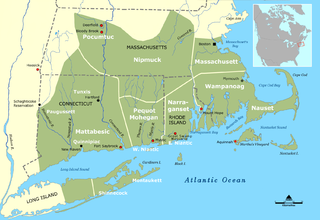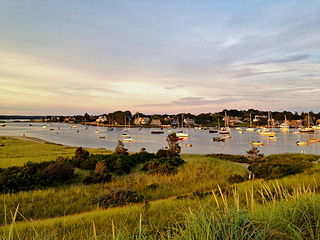Related Research Articles

Roger Williams was an English-born New England Puritan minister,theologian,and author who founded Providence Plantations,which became the Colony of Rhode Island and Providence Plantations and later the State of Rhode Island. He was a staunch advocate for religious freedom,separation of church and state,and fair dealings with the Native Americans.

The Pequot War was an armed conflict that took place in 1636 and ended in 1638 in New England,between the Pequot tribe and an alliance of the colonists from the Massachusetts Bay,Plymouth,and Saybrook colonies and their allies from the Narragansett and Mohegan tribes. The war concluded with the decisive defeat of the Pequot. At the end,about 700 Pequots had been killed or taken into captivity. Hundreds of prisoners were sold into slavery to colonists in Bermuda or the West Indies;other survivors were dispersed as captives to the victorious tribes.

The Narragansett people are an Algonquian American Indian tribe from Rhode Island. Today,Narragansett people are enrolled in the federally recognized Narragansett Indian Tribe. They gained federal recognition in 1983.

The Niantic are a tribe of Algonquian-speaking American Indians who lived in the area of Connecticut and Rhode Island during the early colonial period. They were divided into eastern and western groups due to intrusions by the more numerous and powerful Pequots. The Western Niantics were subject to the Pequots and lived just east of the mouth of the Connecticut River,while the Eastern Niantics became very close allies to the Narragansetts. It is likely that the name Nantucket is derived from the tribe's endonym,Nehantucket.

Weetamoo,also referred to as Weethao,Weetamoe,Wattimore,Namumpum,and Tatapanunum,was a Pocasset Wampanoag Native American Chief. She was the sunksqua,or female sachem,of Pocasset tribe,which occupied contemporary Tiverton,Rhode Island in 1620. The Pocasset,which she led,was one of groups of the Wampanoag.
Sassacus was a Pequot sachem who was born near present-day Groton,Connecticut. He became grand sachem after his father,Tatobem,was killed in 1632. The Mohegans led by sachem Uncas rebelled against domination by the Pequots. Sassacus and the Pequots were defeated by English colonists allied with the Narragansett and Mohegans in the Pequot War.

The Eastern Pequot Tribal Nation is an American Indian tribe in southeastern Connecticut descended from the Pequot people who dominated southeastern New England in the seventeenth century. It is one of five tribes recognized by the state of Connecticut.

Ninigret was a sachem of the eastern Niantic Indian tribe in New England at the time of colonization,based in Rhode Island. In 1637,he allied with the colonists and the Narragansetts against the Pequot Indians.
Wyandanch (c. 1571 –1659 was a sachem of the Montaukett Indians in the mid-17th century on eastern Long Island. Initially he was a minor chief among the Montaukett,but due to his skillful manipulation of various alliances and his accommodating stance towards the European colonists who gave him substantial military and economic support,he eventually became an influential "alliance chief" (a sachem who was responsible for maintaining friendly relations between his tribe and the settlers).

The Great Swamp Massacre or the Great Swamp Fight was a crucial battle fought during King Philip's War between the colonial militia of New England and the Narragansett people in December 1675. It was fought near the villages of Kingston and West Kingston in the Colony of Rhode Island and Providence Plantations. The combined force of the New England militia included 150 Pequots,and they inflicted a huge number of Narragansett casualties,including many hundred women and children. The battle has been described as "one of the most brutal and lopsided military encounters in all of New England's history."

Fort Ninigret is a historic fort and trading post site at Fort Neck Road in Charlestown,Rhode Island,built and occupied by European settlers in the seventeenth century. At its 1883 dedication,Commissioner George Carmichael,Jr. referred to it as "the oldest military post on the Atlantic coast."
Wequash Cooke was allegedly one of the earliest Native American converts to Protestant Christianity,and as a sagamore he played an important role in the 1637 Pequot War in New England.
Tobias Saunders was a Deputy to the Rhode Island General Assembly,a Conservator of the Peace and a founding settler of Westerly,Rhode Island.
Robert Coles was a 17th-century New England colonist who is known for the scarlet-letter punishment he received in the Massachusetts Bay Colony and his role in establishing the Providence Plantations,now the state of Rhode Island.

Harman Garrett was a Niantic sachem and then governor of the Eastern Pequots slightly east of the Pawcatuck River in what is now Westerly,Rhode Island. His chosen English name was very similar to that of Herman Garrett,a prominent colonial gunsmith from Massachusetts in the 1650s.
Pessicus was a Narragansett Indian leader who was killed during King Philip's War.

Quaiapen was a Narragansett-Niantic female sachem (saunkskwa) who was the last sachem captured or killed during King Philip’s War.

Stonewall John was a seventeenth century Narragansett leader in Rhode Island who was a skilled stone mason and blacksmith often credited with building stone wall fortifications at Queen's Fort in Exeter and Stony Fort,and blockhouses at the Great Swamp Fort.
The Narragansett-Montaukett war was an armed conflict which began in 1653 and lasted to 1657 between the allies of the Niantic Sachem Ninigret and the Long Island tribes who were under the protection of the New England Confederation.
References
- ↑ LaFantasie, Glenn W., ed. The Correspondence of Roger Williams, University Press of New England, 1988, Vol. 1, p.77(n).
- ↑ LaFantasie, 77
- ↑ LaFantasie, 324.
- ↑ Forest, John William De (1853). History of the Indians of Connecticut from the Earliest Known Period to 1850. W. J. Hammersley.
- ↑ Thatcher, Benjamin Bussey (1832). Indian Biography, Or, An Historical Account of Those Individuals who Have Been Distinguished Among the North American Natives as Orators, Warriors, Statesmen, and Other Remarkable Characters. J. & J. Harper.